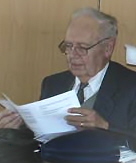The Particlewave: A New Model for Light and the Matter Waves
Year: 2008
Keywords: Particle Wave, Wavelength, Wave-Radius, Frequency, Interference, Photon, Double Helix, Electron Orbit
Since both photons and elementary particles exhibit masslike as well as wavelike properties, it is reasonable to ascribe the motion of those particles to an array of subparticles, which oscillate in the plane perpendicular to their motion. If this oscillation is circularly polarized the path of motion is a helix. This particle wave well describes the dualism of a wave and a corpuscle. If two subparticles take part in the motion the shape is called a double helix. This wave should be stable even if the angle between the oscillation plane and the direction of motion is not perpendicular.
This model might give the following clues:
- the total energy of a particle wave is the sum of its kinetic and potential energy equal to hf = mv2
- the image of the particle and wave is represented by only one picture, the particle wave, and so it may provide a link between quantum mechanics and wave mechanics.


